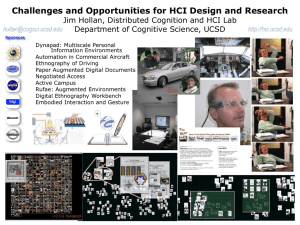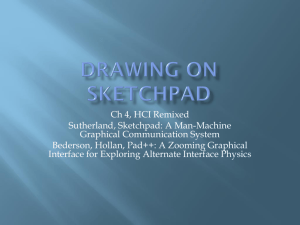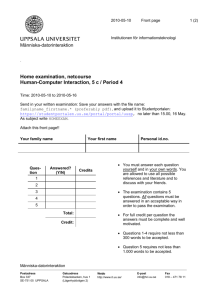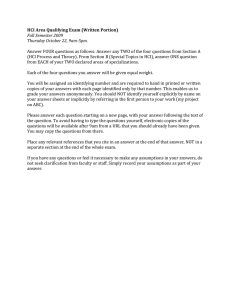Chapter 2.pptx
advertisement
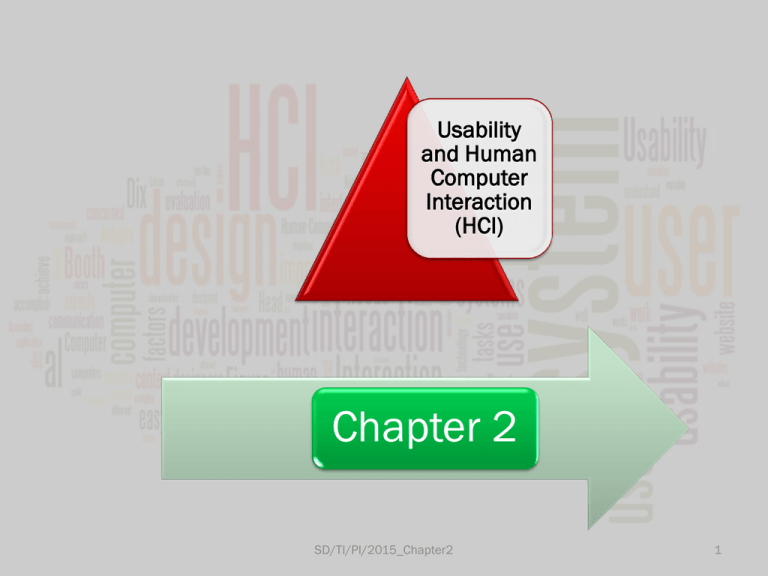
Usability and Human Computer Interaction (HCI) Chapter 2 SD/TI/PI/2015_Chapter2 1 Introduction Chapter Two discusses • the value and the meaning of Human Computing Interaction (HCI) and its usefulness in designing a user interface or website. "Human Computer Interaction (HCI) is about designing a computer system that supports people so that they can carry out their activities productively and safely" (Preece et al. 1994, p.1). HCI plays an • important role in the development of computer systems and websites as it helps to develop “interactional techniques and to suggest where and in what situations these technologies and techniques might be put to best use” (Booth 1989, p.6). SD/TI/PI/2015_Chapter2 2 Introduction HCI is a •“very important concept in the system development process as it is about understanding and creating software and other technology that people will want to use, will be able to use, and will find effective when used. And the usability concept and the methods and tools to encourage it, achieve it, and measure it are now touchstones in the culture of computing” (Carroll 2002, p.xxvii) SD/TI/PI/2015_Chapter2 3 User-Centered System Design In order for computer-based systems to be widely accepted and used effectively, they need to be well designed via a “user-centered” approach. This is not to say that all systems have to be designed to accommodate everyone, but that computer-based systems should be designed for the needs and capabilities of the people for whom they are intended. SD/TI/PI/2015_Chapter2 4 User-Centered System Design In the end, • users should not even have to think about the complexity of how to use a computer. For that reason, computers and related devices have to be designed with an understanding that people with specific tasks in mind will want to use them in a way that is seamless with respect to their work. Additionally, • it is very important to “define style, norms, roles and even mores of human and computer relationship that each side can live with, as computers become more complex, smarter and more capable,” and as we allow them to “take on autonomous or semi-autonomous control of more critical aspects of our lives and society”(Miller 2004, p.34). SD/TI/PI/2015_Chapter2 5 User-Centered System Design Systems designers Head (1999, p. 6) • need to know how to think in terms of future users' tasks and how to translate that knowledge into an executable system. This can be accomplished by establishing a good interface design to let the user interact and deal with the computer without any difficulties and to have more control of the system. • stated that good interface design “is a reliable and effective intermediary, sending us the right cues so that tasks get done – regardless of how trivial, incidental, or artful the design might seem to be”. SD/TI/PI/2015_Chapter2 6 User-Centered System Design Recently, It is primarily concerned with the design of sociotechnical systems that take into account as we know, user-centered design has become an important “concept in the design of interactive system[s]. not only their users, but also the use of technologies in users’ everyday activities, it can be thought of as the design of spaces for human communications and interaction” (DePaula 2003, p.219). SD/TI/PI/2015_Chapter2 7 HCI The general concepts of HCI apply to website design. Website designers have noticed that creating a “user friendly” site is important to maximize user response. However, designers “did[not] know any effective ways to discover what made a product user-friendly or how to design a product that was friendly” (McCracken and Wolfe 2004 p.3). Designers often have a poor understating of HCI issues. Therefore, designers need to know how to think in terms of future users' needs, values, and supportable tasks and how to translate that knowledge into an executable system. This can be accomplished by establishing a good interface design to let the user interact and deal with the websites without any difficulties and to let the user have more control of the site. SD/TI/PI/2015_Chapter2 8 HCI in order to work • effectively in the development process, HCI needs to be part of this process. According to Head, HCI has two critical dimensions in the development process: firstly, involving the user during the building and implementation of the new systems; secondly, evaluation studies about “cognitive and other behavioral factors that come into play when people interact with computers” (Head 1999, p. 9). These dimensions • are consistent and mutually dependent, thus “the evaluation side of HCI becomes(s) a basis for decision making about design trade-offs during product development” (Head 1999, p. 9). SD/TI/PI/2015_Chapter2 9 HCI In the past, Thus, •HCI experts tended to be consulted later in the design process, but most of the research found that this was a mistake. “The Interface is not something that can be plugged in at the last minute; its design should be developed integrally with the rest of the system. It should not just present a "pretty face”; but should support the tasks that people actually want to do, and forgive the careless mistakes” (Dix et al. 2004, p. 3). •it is important to consider how HCI will fit into the overall design process for websites SD/TI/PI/2015_Chapter2 10 Great Usability Satisfaction HCI – In the Past HCI Effectiveness Efficiency Interaction with and through technology HCI – Now Seeking to understand and support human beings HCI – Past and Now –Prepared by Tomayess Issa SD/TI/PI/2015_Chapter2 11 What is HCI? HCI • “is a discipline concerned with the design, evaluation, and implementation of interactive computing systems for human use and with the study of major phenomena surrounding them” (Preece et al. 1994, p. 7). the reasons for SD/TI/PI/2015_Chapter2 • studying HCI in the development process are to create interactive computer systems that are usable and practical as well (Head 1999). 12 What is HCI? The term HCI The implementation of HCI • relates to several stages in the development process, including the design, implementation, and evaluation of interactive systems, in the “context of the user’s task and work” (Dix et al. 2004, p. 4). • can be perceived as an art as well as a science because it requires a comprehensive range of skills, including an understanding of the user, an appreciation of software engineering capabilities and application of appropriate graphical interfaces. “If we are to be recognized as developers with professional capabilities, as competent practitioners, then it is critical to understand what makes an application interactive, instructional and effective” (Sims 1997). SD/TI/PI/2015_Chapter2 13 What is HCI? HCI is •“concerned not only with how present input and output technologies affect interaction, but also with the consequences of new techniques such as speech recognition and generation (input and output)” (Booth 1989, p. 5). SD/TI/PI/2015_Chapter2 14 HCI as Process HCI is HCI places concerned with two issues: studying the relationship and the communication between the human and the computer, and discovering the methods for “mapping computing functions to human capabilities and effectively using input and output techniques so that computers and users have more seamless interactions” (Head 1999, p. 12). a special emphasis on “creating and applying usercentered design techniques as well as using iterative usability testing methods” (Head 1999, p. 13). SD/TI/PI/2015_Chapter2 15 Relationship between the HCI and Human Dialogue the relationship between HCI and human dialogue may be summarized as follows: (Booth 1989, p. 54-55). •Human Computer interaction, like human dialogue, is a form of communication where a degree of understanding can be achieved. Admittedly, this understanding may be limited in some respects, but if designed properly, a computer system will do as its user wishes, provided the user knows what is possible and how to give commands. •Communications requires agreement on the terms used in the dialogue. When humans successfully communicate, they usually have a shared understanding of the words used and the concepts to which they refer. This is also true of human computer communication. When a user gives commands to a system, then the system must have an understanding of these commands if the interaction is going to succeed. •Communications requires agreement, not only upon the terms and concepts used, but also upon the context of the communication. SD/TI/PI/2015_Chapter2 16 Goals of HCI To establish a simple system with good usability, the HCI specialists need to be aware of the following issues (Preece et al. 1994, p. 15): SD/TI/PI/2015_Chapter2 • Understand the factors such as organizational, social, and psychological factors that determine how people operate and make use of computer technology effectively. • Develop tools and techniques to help designers ensure that computer systems are suitable for the activities for which people will use them. • Achieve efficient, effective, and safe interaction in terms of both individual Human Computer Interaction and group interaction. 17 Purpose of HCI The purpose of HCI is to design a computer system to match the needs and requirements of the users. The HCI specialists need to think about the above factors in order to produce an outstanding system. To achieve the goals of HCI, a number of approaches can be utilized. These approaches need to be studied very carefully in order to develop a system, which provides the user with productivity and efficiency. These approaches are: (Preece et al. 1994, p. 46-47) •Involving the user: (involve the user as much as possible so that s/he can influence the system design). •Integrating different kinds of knowledge and expertise: (integrate knowledge and expertise from the different disciplines that contribute to HCI design). •Making the design process iterative: (testing can be done to check that the design does indeed meet users' requirements). SD/TI/PI/2015_Chapter2 18 Organizational factors (training, job design, politics, roles, work organization); Environmental factors (noise, heating, lighting, ventilation); Health and Safety factors (stress, headaches, musculo-skeletal disorders); The User (motivation, enjoyment, satisfaction, personality, experience level); Comfort Factors (input devices, output displays, dialogue structures, use of color, icons, commands, graphics, natural language, 3-D, user support materials, multi-media); User Interface (input device, output displays, dialogue structures, icons, 3-D, multi-media) ; Task Factors (easy, complex, novel, task allocation, repetitive, monitoring, skills, components); Constraints (costs, timescales, budgets, staff, equipment, building structure) System Functionality (hardware, software, application) Productivity Factors (increase output, increase quality, decrease costs, decrease errors, decrease labour requirements, decrease production time, increase creative and innovative ideas learning to new products). Factors in HCI Design Factors in HCI (adapted from Preece et al. 1994) SD/TI/PI/2015_Chapter2 19 HCI Issa (2008) •indicates that HCI is essential in the system development system. HCI will allocate users, analysts, and designers (internal and external) to identify that the website design is practical. Many specific issues need to be taken into consideration when designing website pages, such as text style, fonts; layout, graphics, and color SD/TI/PI/2015_Chapter2 20 The HCI step will HCI step in the New Participative Methodology for Marketing Websites (NPMMW) – Issa 2008 – Prepared by Tomayess Issa SD/TI/PI/2015_Chapter2 • Allocate, users, analysts, and designers (internal and external) to identify that the website design is practical. • There are many specific issues that need to be taken into consideration when designing website pages, such as • Text style • Fonts • Layout • Graphics • Color. 21 Usability Usability refers Alternatively, to the “quality of the interaction in terms of parameters such as time taken to perform tasks, number of errors made, and the time to become a competent user” (Benyon et al. 2005, p. 52). Usability “is a quality attribute that assesses how easy user interfaces are to use. The word "usability" also refers to methods for improving ease-ofuse during the design process” (Nielsen 2003). SD/TI/PI/2015_Chapter2 22 Usability Usability evaluation is about observing users to “see what can be improved, what new products can be developed” (McGovern 2003). It is “based on human psychology and user research” (Rhodes 2000). HCI specialists “observe and talk with participants as they try to accomplish true-to-life tasks on a site (or system), and this allows them to form a detailed picture of the site as experienced by the user” (Carroll 2004). SD/TI/PI/2015_Chapter2 23 Usability Usability is Alternatively, •considered a very important aspect in the development process as it can mean the difference between performing and completing a task in a successful way without any frustration. •if usability is not highlighted in website design, then users will become very frustrated working with it. SD/TI/PI/2015_Chapter2 24 Functionality Efficiency HCI Effectiveness Usability Satisfaction Special Users Specific Goals Usability – Prepared by Tomayess Issa SD/TI/PI/2015_Chapter2 Specific Context of Use 25 Usability According to Nielsen (2003), • people will leave the website: a) if is difficult to use; b) if the users get lost on a website; c) the information is hard to read; d) it does not answer users’ key questions; e) and lastly, if the homepage fails to define the purpose and the goals of the website. “Usability rules the web. Simply stated, if the customer cannot find a product, then s/he will not buy it. In addition, • the web is the ultimate customer-empowering environment. S/he who clicks the mouse gets to decide everything. It is so easy to go elsewhere; all the competitors in the world are but a mouse-click away” SD/TI/PI/2015_Chapter2 26 Concepts of Usability Eason (1984) has suggested a sequence of models that clarify what these variables might be. Figure 6 displays the relationship between independent (task, user, and system characteristics) and dependent variables (User Reaction) with each variable having specific requirements and needs. SD/TI/PI/2015_Chapter2 27 Independent variables System Functions Task Match Ease of Use Ease of Learning User Characteristics Task Characteristics Knowledge Discretion Motivation Frequency Openness User Reaction Dependent variables Implicit cost/benefit analysis Positive outcome Good task-system match, Continued user learning Negative outcome Eason's Causal Framework of Usability (Adopted from Eason 1984) - Prepared by Tomayess Issa SD/TI/PI/2015_Chapter2 Restricted use Non-use, Partial use, Distant use28 Usability Criteria based on Dix et al. 1998, p. 162 and Nielsen 2003: Learnability: by which new users can begin effective interaction and achieve maximal performance; Flexibility: the multiplicity of ways the user and system exchange information; Robustness: the level of support provided to the user in determining successful achievement and assessment of goals; Errors: “How many errors do users make, how severe are these errors, and how easily can they recover from the errors? ( Nielsen 2003); Memorability: how easily the user will remember the system functions, after a period time of not using it; Efficiency: once the user learns about the system,[the speed with which s/he] can perform the tasks; Satisfaction: how enjoyable and pleasant is it to work with the system? SD/TI/PI/2015_Chapter2 29 Usability Specifications Usability specifications should lay out explicitly how usability will be evaluated and can be divided into two sections: Performance Measures: are directly observable by watching a user complete a task within a specific time. This includes monitoring the number of errors and time needed to accomplish the task. These types are ‘quantifiable measures’ which means that they can be communicated with numbers. For example “you can count the number of minutes it tasks a user to complete a task or the number of negative comments that occur” (McCracken and Wolfe 2004, p. 53). Preference Measures: give an indication of a “user’s opinion about the interface which is not directly observable” (McCracken et al. 2004, p. 53). Preference measures can be determined by using questionnaires or interviews. SD/TI/PI/2015_Chapter2 30 Usability Issa (2008) confirm that usability is a core step in the system development process as usability will allow users, analysts, and designers (internal and external) to confirm that the website design is efficient, effective, safe, utility, easy to learn, easy to remember, easy to use and to evaluate, practical, visible and provide job satisfaction SD/TI/PI/2015_Chapter2 31 The Usability step will • allow users, analysts, and designers (internal and external) to confirm that the website design is • Efficient • Effective • Safe • Has utility • Easy to learn • Easy to remember • Easy to use and to evaluate • Practical, visible, • Job satisfaction. HCI step in the New Participative Methodology for Marketing Websites (NPMMW) – SD/TI/PI/2015_Chapter2 32 Issa 2008 – Prepared by Tomayess Issa Conclusion HCI and usability •are needed in any design, including sustainable design to recognize the new smart technology and portable device needs from designers and users perspective. Therefore, •designers should integrate and combine HCI and usability in their agenda design, including sustainable design, to enhance new smart technology and portable devices performance and facilities, and to satisfy users’ needs. SD/TI/PI/2015_Chapter2 33




